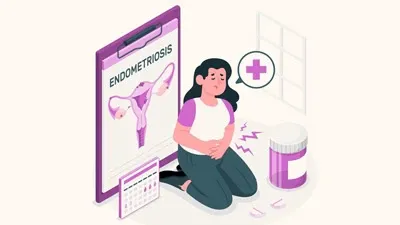These could be symptoms of endometriosis, a chronic condition affecting millions of women worldwide. Endometriosis occurs when tissue similar to the lining of the uterus grows outside it, often leading to severe pain, inflammation, and complications with fertility. While medical treatments are crucial, incorporating regular exercise into your routine can offer significant relief. We spoke to our expert Dr Tejal Kanwar, Gynaecologist and Consultant, Ujaas (a menstrual health and hygiene management social enterprise), who explained the role of exercise in managing endometriosis.
According to a 2022 study, endometriosis is one of the most complex gynaecological conditions, affecting 10-15% of women of reproductive age and 70% of those with chronic pelvic pain. The ovaries and pelvic peritoneum are the most common areas where endometriotic lesions develop.
How Does Exercise Help In Managing Endometriosis?
Here are four ways exercise can help those living with endometriosis:
1. Pain Reduction
One of the most significant benefits of exercise for endometriosis sufferers is pain reduction. "Regular physical activity stimulates the , the body's natural pain relievers. These 'feel-good' hormones can help alleviate the chronic pain associated with endometriosis, particularly during menstruation," said Dr Tanwar.
Low-impact exercises, such as swimming and yoga are especially beneficial. These activities promote gentle movement and stretching, which can help relax tense muscles and reduce pelvic pain. Consistency is key, therefore, aim for at least 30 minutes of moderate exercise most days of the week to experience the pain-reducing benefits.
According to a 2014 study, when evaluating physical activity levels four years before an endometriosis diagnosis, patients who engaged in 42 Metabolic Equivalent (MET) hours per week had a 90% lower risk of developing the condition compared to those who only exercised three MET hours per week.
2. Improved Circulation
Performing exercise increases blood flow throughout the body, including the pelvis. This improved circulation can help reduce inflammation, a common issue for those with endometriosis. "Better blood flow also means more oxygen and nutrients are delivered to the affected areas, potentially aiding in healing and reducing the formation of scar tissue," added Dr Tanwar.
Cardiovascular exercises like brisk walking, cycling, or dancing are excellent choices for boosting circulation. These activities get the heart pumping and blood flowing, which can help alleviate some of the discomfort associated with endometriosis.
3. Stress Reduction
Living with a chronic condition like endometriosis can be emotionally and mentally taxing. Stress can exacerbate symptoms and lead to a cycle of pain and anxiety. Exercise is a proven stress-buster, helping to clear the mind and promote well-being.
Activities like yoga and tai chi are particularly effective for stress reduction, as they combine physical movement with mindfulness and breathing techniques. These practices can help manage stress levels, improve sleep quality, and enhance overall mental health, which are all crucial factors in coping with endometriosis.
4. Hormonal Balance
"Regular exercise can help regulate hormones in the body, which is particularly important for those with endometriosis. Physical activity has been shown to reduce oestrogen levels, potentially slowing the growth of endometrial tissue outside the uterus," said Dr Tanwar.
Not only this, exercise can also help in healthy weight management. Excess body fat produces extra oestrogen, which can worsen endometriosis symptoms. By keeping weight in check through a combination of exercise and a balanced diet, women may be able to better manage their condition.
Bottomline
Dr Tanwar concluded, "While exercise isn't a cure for endometriosis, it can be a powerful tool for managing symptoms and improving overall health. As with any new exercise regimen, it's important to start slowly and listen to your body. Consult with your healthcare provider to develop an exercise plan that's safe and effective for your individual needs."
